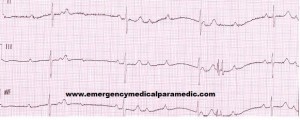Third Degree AV Block (Complete Heart Block)
A Third Degree AV Block (Complete Heart Block) is where there is a complete conduction block between the atria and the venticles, which results in no correlation between contractions of either the atria or the ventricles. A Third Degree AV Block is a life threatening emergency, and if left untreated can result in sudden cardiac death syndrome. Treatment requires cardiac pacing through either an emergency external pacemaker or an internal pacemaker.
Third Degree AV Block (Complete Heart Block) ECG
Heart Rate: the atrial rate is likely to be normal (60-100 per minute), where as the ventricle rate is usually as low as 30-40 beats per minute.
Rhythm: the ventricular rhythm is essentially regular.
Pacemaker Site: there are two pacemaker sites. The SA node, which allows the atrium to contract, and depending on the site of the AV blockage the AV junction or ventricles will be the main pacemaker site for the ventricles.
QRS Complexes: normal or abnormal.
Third Degree AV Block (Complete Heart Block) Signs and Symptoms
The person is likely to look poorly perfused. Symptoms will include: dizziness, chest pain, chest tightness, shortness of breath and palpitations.
Return to: ECG Interpretation Tutorial.
Next page in the ECG Interpretation Tutorial:

